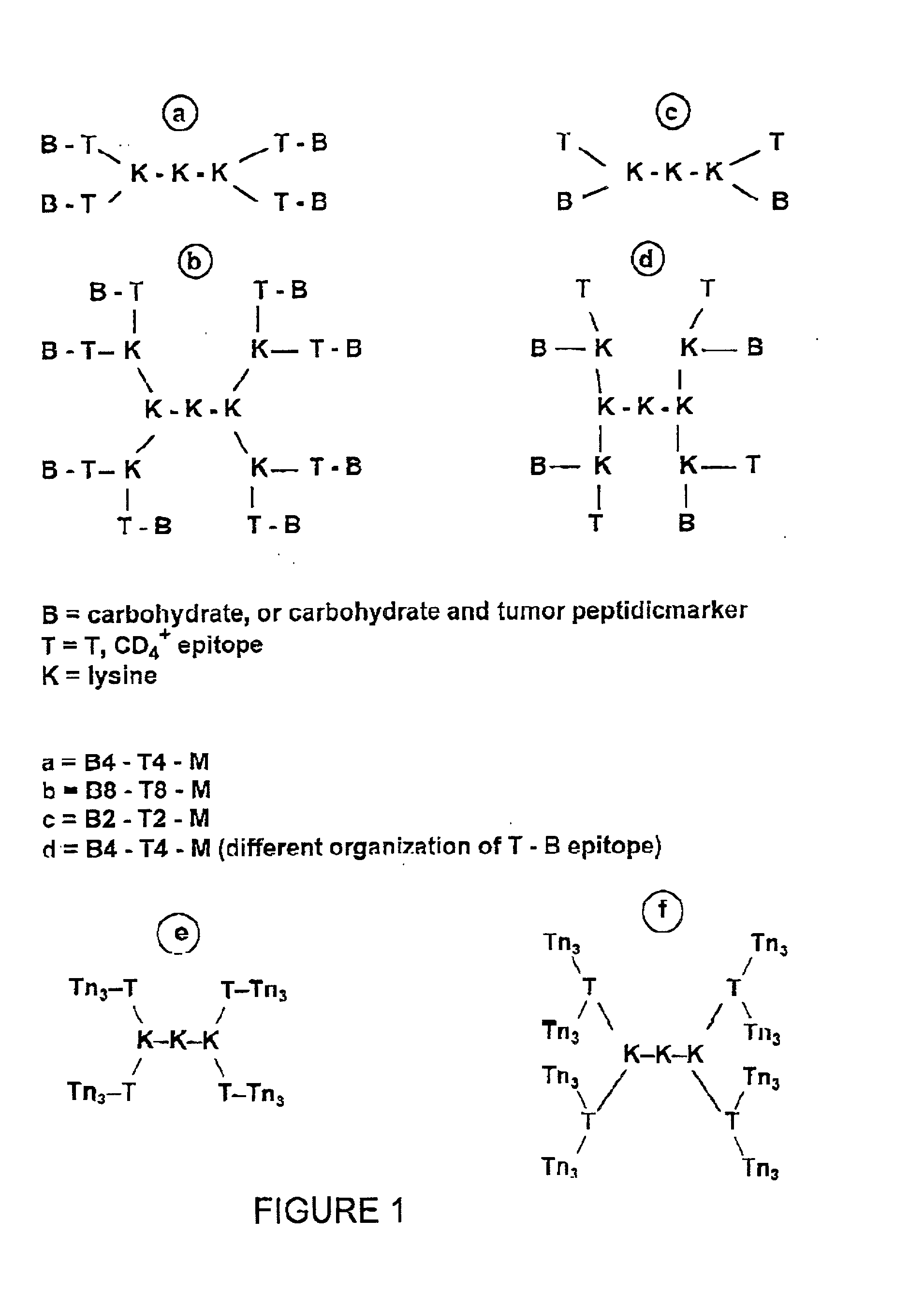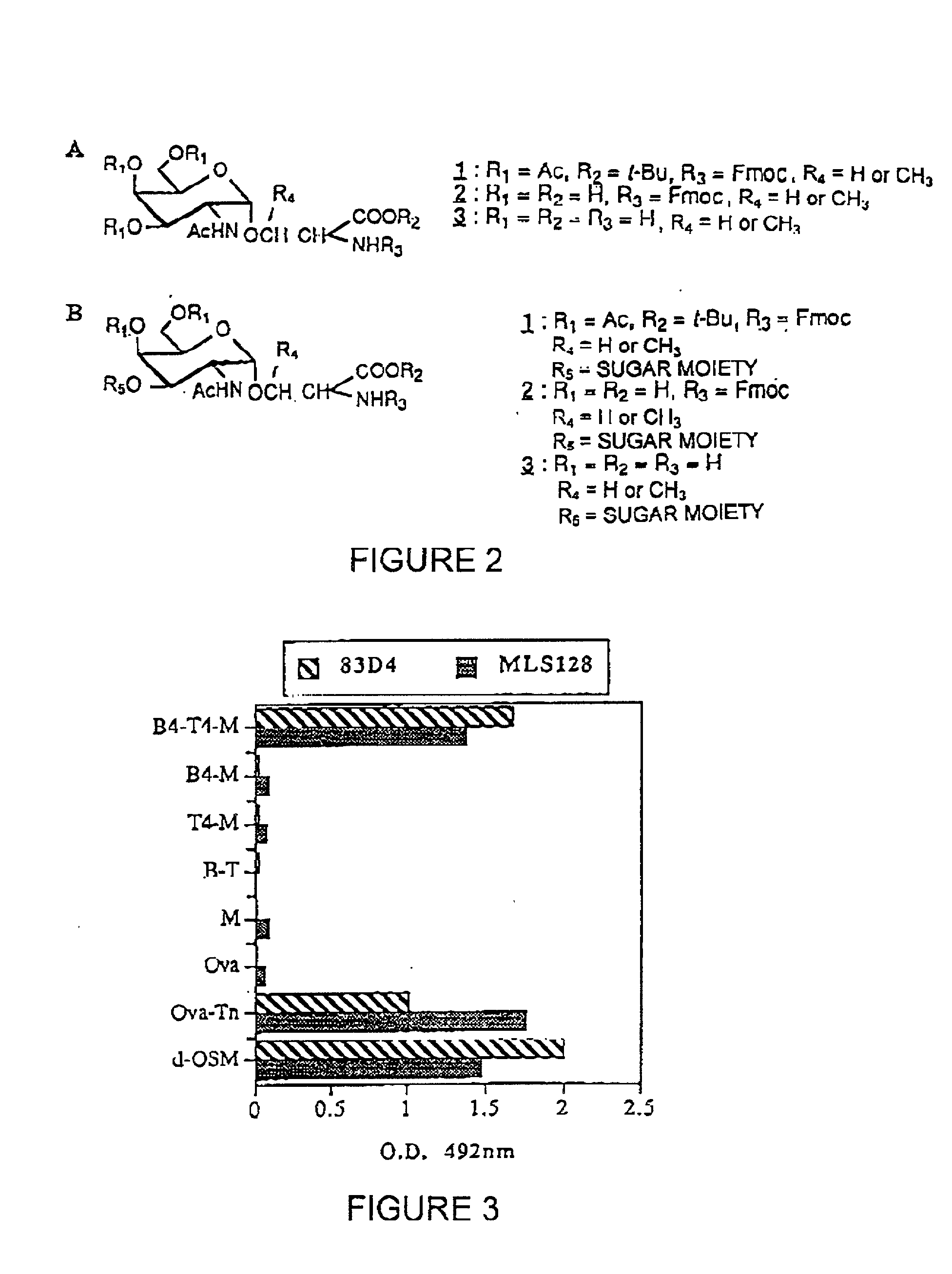Multiple antigen glycopeptide carbohydrate vaccine comprising the same and use thereof
a glycopeptide and carbohydrate technology, applied in the field of immunotherapy, can solve the problems of ambiguity in composition and structure, low level of desired antibodies, and inducible immune respons
- Summary
- Abstract
- Description
- Claims
- Application Information
AI Technical Summary
Benefits of technology
Problems solved by technology
Method used
Image
Examples
first embodiment
[0138] In the linear carbohydrate peptide conjuguate described above, the peptide and the carbohydrate moiety are directly covalently bound within the molecule.
second embodiment
[0139] In the linear carbohydrate peptide conjuguate of the invention, the peptide and the carbohydrate moiety are linked via a spacer.
[0140] In a first aspect, the spacer consists of an aminoacid chain. This aminoacid chain may have an aminoacid lenght of 1 to 5 aminoacids.
[0141] In a second aspect, the spacer consists of a carbohydrate residue or of a chain of multiple carbohydrate residues.
[0142] The spacer can be also an aliphatic chain (1 to 10 carbon atoms).
[0143] Most preferably, the carbohydrate moiety comprised in the carbohydrate peptide conjugate described above is selected from the group consisting of 1 to 6 residues of a Tn antigen, or a Tn antigen derivative.
[0144] These linear carbohydrate peptide conjuguates according to the invention have been successfully used to induce a high level of antibodies specific to the carbohydrate moiety, and particularly to the Tn carbohydrate moiety which mimic a tumoral cell antigen.
[0145] Thus these linear carbohydrate peptide conjug...
example 1
Synthesis of the Glycoconjugate According to the Invention
[0188] The strategy for the construction of the MAG conjugate first involved the synthesis of the Tn antigen which represents the B cell epitope. This glycosidic tumor marker was then conjugated to a poly-lysine core (M) in association with the peptidic CD4.sup.+, T cell epitope, giving the full construction B4-T4-M. In addition, the reference compounds which are necessary for the immunological tests were synthetized (B, T, B T, B4 M, T4 M, M).
[0189] The synthesis of the Tri antigen 2 (FIG. 2) was performed by classical methods (Ref. 19, Ref. 20) starting from tri-O-acetyl-D-galactal (Shafizadeh et al. (1989)). N (Fluorenylmethoxycarbonyl)-L-serine tert-butyl ester (Vowinkel et al. (1967), Schultz et al. (1993)) was used for the Koenigs-Knorr reaction with 3,4,6-tri-O-acetyl-2-azido-2-deoxy-b-D-galactopyranosyl chloride (Lemieux et al. (1979), Ferrari et al. (1980)), giving the protected derivative 1. The final deprotection o...
PUM
| Property | Measurement | Unit |
|---|---|---|
| reaction time | aaaaa | aaaaa |
| flow rate | aaaaa | aaaaa |
| pH | aaaaa | aaaaa |
Abstract
Description
Claims
Application Information
 Login to View More
Login to View More - R&D
- Intellectual Property
- Life Sciences
- Materials
- Tech Scout
- Unparalleled Data Quality
- Higher Quality Content
- 60% Fewer Hallucinations
Browse by: Latest US Patents, China's latest patents, Technical Efficacy Thesaurus, Application Domain, Technology Topic, Popular Technical Reports.
© 2025 PatSnap. All rights reserved.Legal|Privacy policy|Modern Slavery Act Transparency Statement|Sitemap|About US| Contact US: help@patsnap.com



